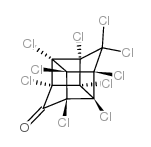开蓬
一般危化品

开蓬结构式
|
常用名 | 开蓬 | 英文名 | 1,3,4-Metheno-2H-cyclobuta[cd]pentalen-2-one,1,1a,3,3a,4,5,5,5a,5b,6-decachlorooctahydro- |
|---|---|---|---|---|
| CAS号 | 143-50-0 | 分子量 | 490.63600 | |
| 密度 | 2.27g/cm3 | 沸点 | 459.7ºC at 760 mmHg | |
| 分子式 | C10Cl10O | 熔点 | 350ºC (decomp) | |
| MSDS | 中文版 美版 | 闪点 | >100ºC | |
| 符号 |



GHS06, GHS08, GHS09 |
信号词 | Danger |
|
Potentiation of halomethane hepatotoxicity: chlordecone and carbon tetrachloride.
Fundam. Appl. Toxicol. 4(3 Pt 1) , 295-308, (1984) The propensity for chlordecone to potentiate hepatotoxicity of CCl4 and some related analogs (CHCl3 and CBrCl3) has been well established. The interaction results in potentiation of halomethane hepatotoxicity at incredibly small, nontoxic levels of chlordecon... |
|
|
Impacts of molt-inhibiting organochlorine compounds on epidermal ecdysteroid signaling in the fiddler crab, Uca pugilator, in vitro.
Comp. Biochem. Physiol. C. Toxicol. Pharmacol. 150(4) , 436-41, (2009) Because of their chemical stability and lipophilicity, many organochlorine compounds (OCs) can readily accumulate in fatty tissues of crustaceans. Several OCs have been reported to inhibit crustacean molting. To determine whether the disruption of crustacean ... |
|
|
ATSDR evaluation of health effects of chemicals. II. Mirex and chlordecone: health effects, toxicokinetics, human exposure, and environmental fate.
Toxicol. Ind. Health 11(6) , 1-203, (1995) This document provides public health officials, physicians, toxicologists, and other interested individuals and groups with an overall perspective of the toxicology of mirex and chlordecone. It contains descriptions and evaluations of toxicological studies an... |
|
|
Cytotoxic effects and aromatase inhibition by xenobiotic endocrine disrupters alone and in combination.
Toxicol. Appl. Pharmacol. 222(2) , 129-40, (2007) Xenobiotics may cause long-term adverse effects in humans, especially at the embryonic level, raising questions about their levels of exposure, combined effects, and crucial endpoints. We are interested in the possible interactions between xenobiotic endocrin... |
|
|
Organochlorine pollution in tropical rivers (Guadeloupe): role of ecological factors in food web bioaccumulation.
Environ. Pollut. 159(6) , 1692-701, (2011) Concentrations of organochlorine pesticides and stable isotope ratios of nitrogen and carbon were measured in a tropical freshwater ecosystem to evaluate the contamination level of biota and examine the bioaccumulation patterns of pollutants through the food ... |
|
|
Cognitive, visual, and motor development of 7-month-old Guadeloupean infants exposed to chlordecone.
Environ. Res. 118 , 79-85, (2012) The insecticide chlordecone was extensively used in the French West Indies to control banana root borer. Its persistence in soils has led to the widespread pollution of the environment, and human beings are still exposed to this chemical. Chlordecone has been... |
|
|
Exposure to an organochlorine pesticide (chlordecone) and development of 18-month-old infants.
Neurotoxicology 35 , 162-8, (2013) Chlordecone is a persistent organochlorine pesticide that was used in the French West Indies until the early 1990s for banana weevil borer control. Human exposure to this chemical in this area still occurs nowadays due to consumption of contaminated food. Alt... |
|
|
Chlordecone exposure and risk of prostate cancer.
J. Clin. Oncol. 28(21) , 3457-62, (2010) Determining whether environmental estrogens are associated with the risk of prostate cancer may have important implications for our general understanding of this disease. The estrogenic insecticide chlordecone was used extensively in the French West Indies, c... |
|
|
Kepone.
Rep. Carcinog. 12 , 250-1, (2011)
|
|
|
Estrogenic activity of the insecticide chlordecone in the reproductive tract of birds and mammals.
J. Toxicol. Environ. Health A 8(5-6) , 731-42, (1981)
|